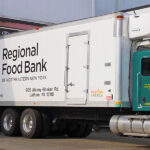BioCycle March/April 2019
Springfield, Illinois: Mapping Composting Facilities
The Illinois Food Scraps Coalition’s (IFSC) latest newsletter features a Permitted Compost Facility Map created by the Illinois Environmental Protection Agency (IEPA). Notes IFSC: “The map shows IEPA permitted commercial composting facilities. Facilities that are IFSC members are marked with a green star. Each facility is different and not all accept drop-offs, food waste, or compostable serviceware. Review the information on the map or contact the facility to learn what materials are accepted, who may bring in compostable material, and what finished compost products are available.”
The newsletter also noted that 8 new residential curbside composting programs were started in Illinois in 2018 in the communities of Batavia, Evanston, Geneva, Gurnee, Kildeer, Lake Barrington, Riverside, and Round Lake Beach. In 2017, the state had 25 curbside food waste collection programs, according to BioCycle’s 2017 Residential Food Waste Collection Access in the U.S. report.
Baltimore, Maryland: Mayor Advocates Composting
“Composting is everybody’s business and responsibility,” stated City of Baltimore Mayor Catherine E. Pugh at the Natural Resources Defense Council’s Food Matters Cities Summit on February 12 in New York City. Mayor Pugh was discussing Baltimore City’s Office of Sustainability’s Food Waste & Recovery Strategy released last fall (written in partnership with the Institute for Local Self-Reliance) that set goals to do the following by 2040: Reduce commercial food waste by 50 percent and household food waste by 80 percent; Ensure all city residents have access to organics collection at home or in their neighborhood; and Divert 80 percent of residential food and organic waste from landfill and incineration.
Pugh emphasized that managing food waste is an economic development tool that can provide livable wages for composting workers, and envisions more neighborhood farms in Baltimore City. She is also laser focused on youth employment, adding, “We need to get young people engaged in composting.”
Davis, California: $4.7M To Study Storing GHG In Soil
California leads the nation in reducing greenhouse gas (GHG) emissions, but reductions alone will not be enough to reach the targets set by the 2015 Paris climate agreement. To do that, GHGs like carbon dioxide (CO2) will need to be removed from the atmosphere on a monumental scale. An ambitious new multicampus, multipartner consortium led by the University of California (UC), Davis and the UC Working Lands Innovation Center, is undertaking a study to find ways to capture billions of tons of CO2 and bring net carbon emissions in California to zero by 2045.
The consortium has received a three-year, $4.7 million grant from the state of California’s Strategic Growth Council to research scalable methods of using soil amendments — including rock, compost and biochar — to sequester GHGs like CO2 in soil. To find out whether adding pulverized rock, compost and biochar to different types of crops and rangelands can significantly sequester carbon, the consortium will conduct and oversee 29 treatment and control sites across California. The studies will assess whether soil amendments can bring additional co-benefits, such as improved crop and rangeland productivity and soil health to California growers and ranchers across diverse regions. The sites range from croplands in the Sacramento and San Joaquin valleys to the Imperial Valley, as well as ranchlands from Marin County to Southern California.
“Previous research points to some promising avenues for carbon capture and storage through use of soil amendments,” notes UC Berkeley Professor Whendee Silver, a Co-Principal Investigator. “For example, we found that adding organic wastes like food waste, green waste, and livestock manure as composted soil amendments could save the equivalent of 28 million tons of CO2 using just 5 percent of California’s rangelands. That’s equal to approximately 80 percent of the emissions from the state’s agriculture and forestry sector.” At the end of the three years, the consortium plans to deliver the most promising “shovel-ready” soil amendment strategies for capturing CO2 in soil.
Enfield, Connecticut: Compost Heat Recovery Report
Connecticut Resource Conservation and Development (CTRC&D), through its Connecticut Farm Energy Program, implemented the state’s first on-farm Compost Aeration and Heat Recovery System (CAHRS) in 2017 at the Collins Powder Hill Farm, a 180-acre dairy farm in the town of Enfield. The Connecticut Farm Energy Program promotes energy efficiency and conservation on farms across the state. The project was paid for in part with funds from the Connecticut Department of Energy and Environmental Protection and the U.S. Department of Energy ($65,000); the balance ($45,000) was paid by the farm. CTRC&D recently released a report based on CAHRS’ performance and an economic analysis, using data from the first year of operation.
The Collins Farm had been using turned windrows to compost farm manure, sand-based animal bedding and other carbon-rich amendments. It switched to negatively aerated static piles (ASP) with installation of Agrilab Technologies Inc.’s Compost Hot Skid 250R plug-and-play heat recovery system that includes a mix of mechanical aeration, heat recovery, plumbing, monitoring, and control components. Negative aeration draws vapor through pipes into the Hot Skid 250-R using a blower fan, while pulling fresh air and oxygen into the composting piles. The hot vapor runs through a heat exchanger to heat a water/glycol loop, condensing some vapor into liquid form. The heated water/glycol fluid is used to preheat wash water and provide space heating in the dairy’s milking barn. The cooled return water/glycol then passes through the skid for reheating in a closed loop system.
Over the first year of operation of the CAHRS, the Collins Farm has saved 1,400 gallons of diesel fuel consumption and 400 labor and equipment hours (primarily as a result of switching to the ASP system). With a 12-month average of $2.40/gallon, the diesel savings total $3,360. At $50/hour (separate from diesel costs), labor and equipment savings total $20,000. Preheating wash water in the dairy barn with recovered heat over 12 months offset heating oil consumption by 760 gallons at $3/gal average or $2,280 annually. The Collins Farm also attributes an increase in compost sales revenues of about $21,600 in spring of 2018 to the more efficient composting process — shortening production time to about 6 months versus the previous 2-year production cycle.













